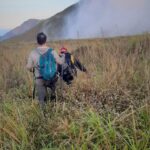- Land leeches are typically small, ranging from a few centimeters to a couple of inches in length.
- They have a worm-like appearance with a flattened body, allowing them to move easily through vegetation.
- Their bodies are often brown or dark in color, helping them blend into their natural environment.
The Philippine Land Leeches
Philippine land leeches, locally known as "limatek", are blood-feeding parasites found in various parts of the Philippines. These leeches belong to the family Haemadipsidae and are different from their aquatic counterparts. Here's more information about these tiny creatures, their behavior, and where they are typically found:
-
Physical Characteristics
-
Habitat
- Land leeches are commonly found in humid and forested areas throughout the Philippines.
- They thrive in environments with dense vegetation, including rainforests, jungles, and wooded areas.
- These leeches are often found in leaf litter, on moist rocks, or on vegetation near the ground.
Philippine mountains known for their notable presence of land leeches:
- Mount Makiling (Laguna)
- Mount Halcon (Mindoro)
- Mount Napulauan (Hungduan)
-
Behavior
- Land leeches are blood-feeding ectoparasites, which means they attach themselves to the skin of their hosts to feed on their blood.
- They do not run away from humans.
- They are attracted to warmth, humidity, and carbon dioxide emissions from animals, including humans.
- Leeches use their specialized anterior suckers to latch onto their host's skin.
- Once attached, they use sharp jaws to make small incisions in the skin, releasing an anti-coagulant enzyme to prevent the host's blood from clotting.
- Their bite is painless. You won't even feel its there.
- Leeches feed until they are engorged, at which point they drop off their host.
-
Are They Dangerous?
That depends on how many leeches are feasting on you. Leeches typically feed for about 20 or 30 minutes before dropping off your body. Bleeding from a leech bite lasts several minutes to a few hours. In most cases, if you are healthy and get a single leech bite, you’ll have some bleeding but you'll be fine. But if there are more than 50 of these leeches feasting on you at once, the consequences can be more serious.
-
Can They Spread Disease?
Yes, it's possible, but there is no record or evidence of them transmitting diseases to humans. Leeches don’t have an immune system that sterilizes their gut contents like humans do. If a leech has bacteria, virus or parasites in its gut and it attaches to you and there’s any regurgitation of blood from their gut onto your wound, that can transmit infection. A leech might regurgitate germ-filled blood if you try to forcefully pull it out, squeeze or burn.
PRECAUTIONS AND AVOIDANCE
To reduce or avoid encounters with land leeches while hiking or exploring the outdoors in the Philippines, here are some tips:
1. Wear Long Clothing, Scarf and Gloves
- Leeches typically attach themselves to exposed skin. Wear long pants and long-sleeved upper garments to minimize the skin's surface area.
- Tuck your pants into your socks and your shirt into your pants to create a barrier for leeches.
- Wear a scarf to cover neck and ears.
- Wear gloves and tuck your long-sleeved shirt into it.

2. Wear High Boots and Leech Socks or Gaiters
- Opt for high-quality boots that cover your ankles.
- Leech socks are specially designed to prevent leeches from getting to your skin. They are typically made of tightly woven fabric.
- Alternatively, use gaiters, which cover your lower legs and are often equipped with repellent coatings.
3. Apply Leech-Repellent Products
- Use leech repellent sprays or lotions on your clothing, socks, and boots.
- Some hikers find success with natural repellents like citronella or eucalyptus oil.
4. Stay On Established Trails
- Leeches are more common in dense vegetation and moist environments. Staying on marked trails can reduce the likelihood of encountering them.
5. Keep Moving
- Leeches are more likely to attach themselves when you're stationary. Keep a steady pace while hiking to minimize opportunities for leeches to climb on.
6. Stay Dry
- Leeches are attracted to moisture and can be more active during and after rain. Try to keep your gear and clothing as dry as possible.
7. Regularly Check for Leeches
- Periodically inspect your clothing, boots, and body for any leeches that may have attached themselves.
- Remove leeches gently by sliding a fingernail or a flat object between the leech and your skin. Apply antiseptic to the bite wound to avoid infection.
- Hiking with others can be beneficial, as they can help spot and remove leeches from your clothing or skin.

Blood oozes from the skin after a leech bite primarily due to the leech's feeding mechanism and the anticoagulant substances it releases. After a leech bite, the wound may continue to ooze blood for a short time even after the leech has detached, but it should eventually stop, and the wound typically heals on its own.
8. Accept Its Existence
- Accept that encountering leeches may be inevitable in certain regions. Stay calm and follow the above precautions to minimize their impact on your hike.

Remember that while Philippine land leeches can be a nuisance, there is generally no documented evidence of them causing significant blood loss or transmitting diseases. Keeping these tips in mind can help you enjoy your hiking experience in the beautiful wilderness of the Philippines while minimizing encounters with leeches.








